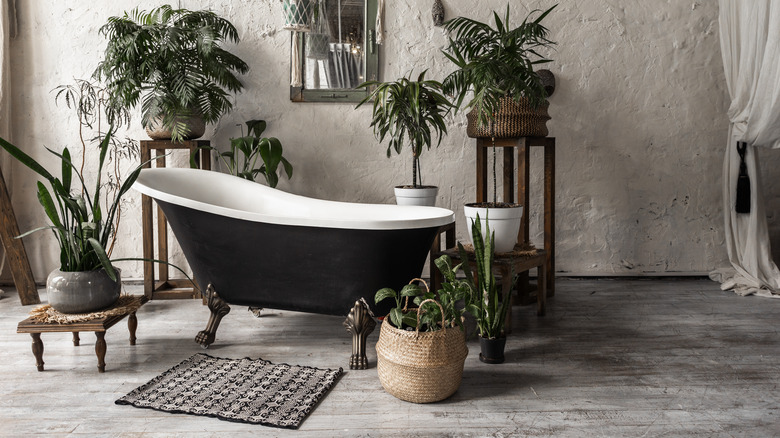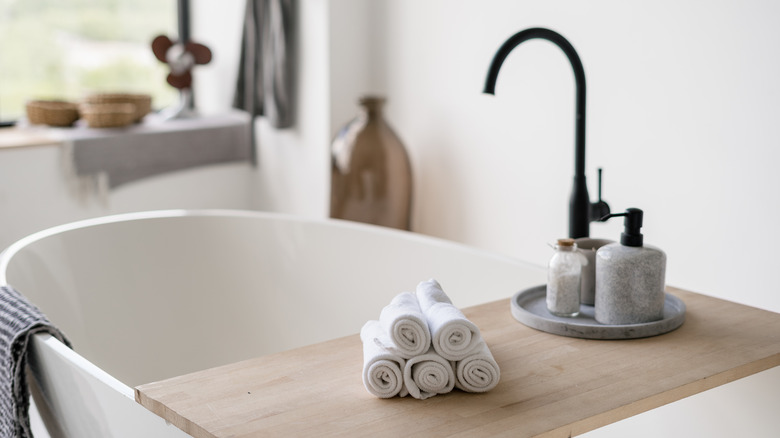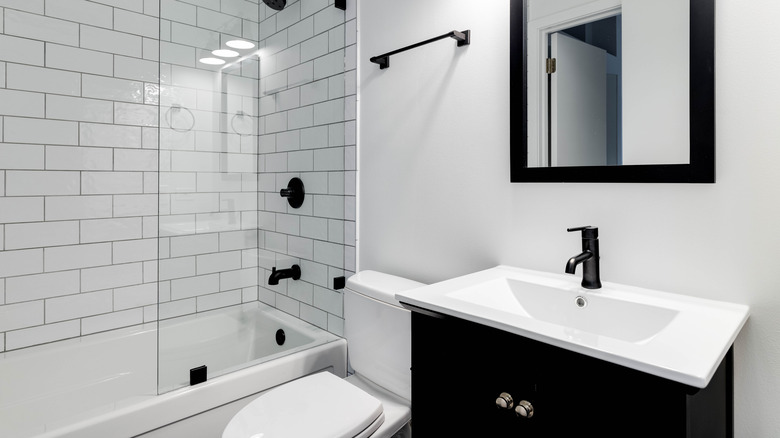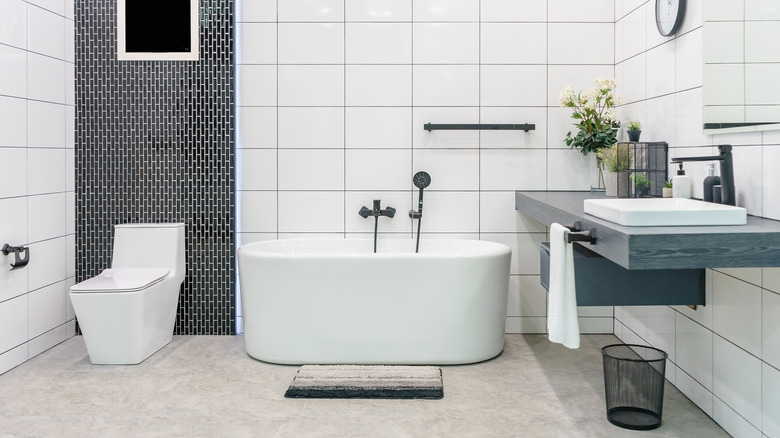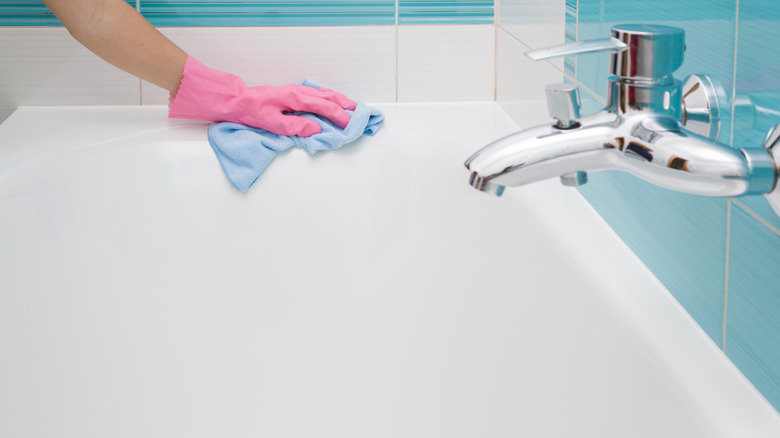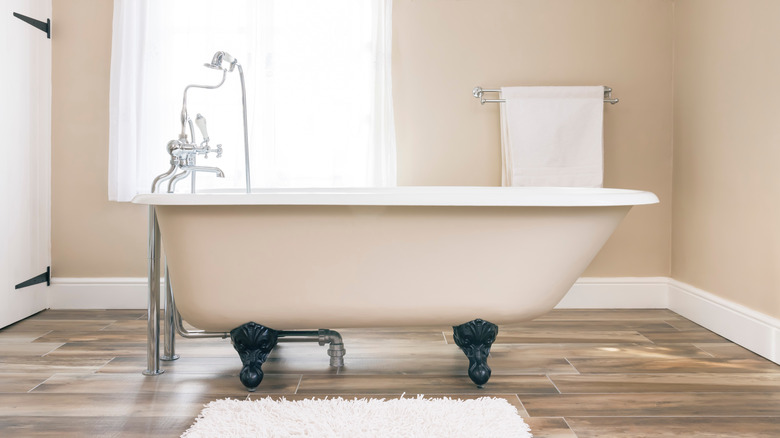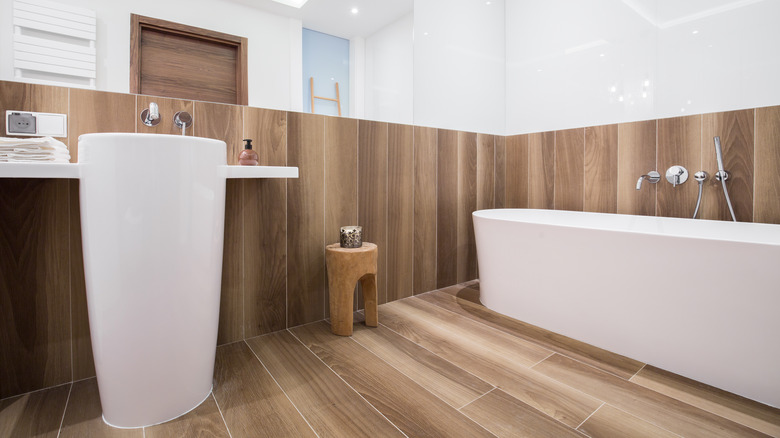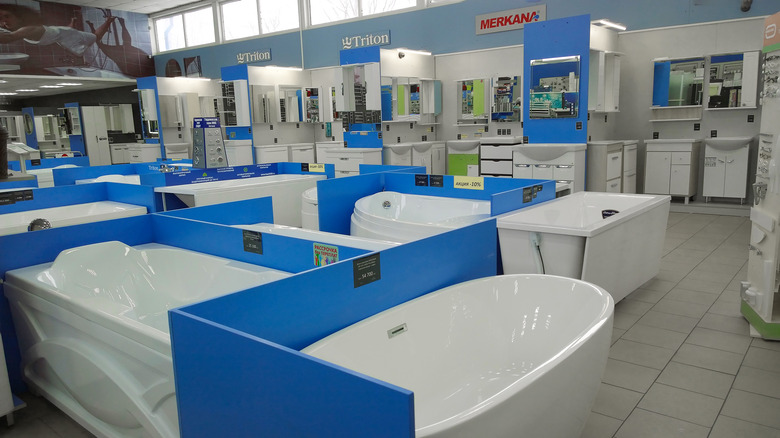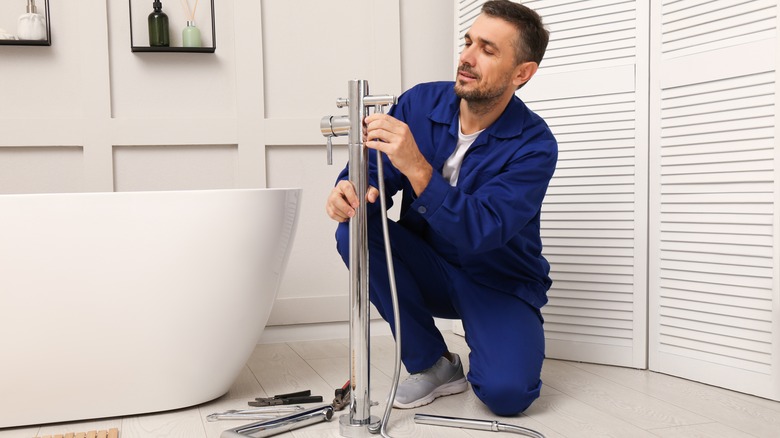Mistakes Everyone Makes When Buying A Bathtub
You dream of soaking in a warm bath, surrounded by candles and soft music. Why only dream about this lovely scenario? Avoid the mistakes everyone makes when buying a bathtub and create the perfect little escape right in your bathroom. Bathtubs are perfect for more than relaxing — they also offer health benefits. According to Pentucket Medical, a warm bath helps balance hormones, improves blood flow, and moisturizes our skin and hair. That's some great news, but that's not all. Tubs also work well when we need to get clean. According to Scott McGillivray, bathtubs are perfect for bathing small children and relaxing sore muscles. They are also available in various sizes and styles, and offer special features like jets and whirlpools. Let's hear it for bathtubs.
Today we have an overwhelming but fun selection to choose from, including freestanding tubs, a wide choice of materials, and unique surrounds to fit any style or budget. Still, if you aren't ready to let go of the shower, there is always the tub/shower combo or a separate tub and shower in one bathroom. But because there are so many options, it's easy to misstep and make mistakes. After all, there is a lot to weigh and consider when making a tub choice. This article will look at the many bathtub options and the things you should consider when shopping for one.
Choosing the wrong size
Bigger isn't always better, and a bathtub that's too small won't get used. Choose the proper size for your home by envisioning what you want and then measuring correctly. The size of your bathroom plays an important role in deciding how big the bathtub can be. You don't want a tub that overwhelms the room, but you also don't want it to look lost. Still, it's your home, and it's up to you how much space you're willing to take up with the tub. Do you and your partner enjoy a romantic soak together? If so, you'll be sorely disappointed to climb in and realize you can't both fit. On the other hand, if the goal is to have a safe and comfortable place to wash the kiddos, you don't want a giant tub where your baby can float to the other side if you let go for a second.
In a large bathroom, a small soaker tub looks elegant and trendy, placed right in the middle of the room. In a more traditional bathroom layout, there may be a tub/shower combo, and simply replacing the tub there requires precise measurements, so it fits properly against the wall and into the corners. According to Vevano Home, you must measure six bathtub areas to find the correct fit. First, measure the overall length, which is the longest part of the tub. Second, measure the widest part of the tub, across the top. Third, find the overall height by measuring from the floor to the top rim, and fourth, get the inside length of the basin, which is the inner part of the bathtub that fills with water. Next is the width of the basin, and the final measurement should be the soaking depth of the tub, which measures from the bottom of the basin to the overflow slots at the top. You'll have a perfectly sized tub installed in your bathroom using this method of measuring,
Not deciding if you want comfort or function
What is the purpose of a bathtub in your bathroom? It isn't the same for everyone. If you plan on soaking for hours, you'll be disappointed to find your new tub isn't comfortable. Did you know bathtubs come in different shapes, not just different sizes? Just as it's important to find the right size to suit your needs, it's also essential to make sure your tub is comfortable and ready to function the way you and your family need it to.
According to Quality Bath, there are eight different bathtub shapes: oval, round, square, corner, rectangular, slipper, hourglass, and custom shapes. You probably see oval and rectangular tubs more often than other shapes. The oval shape is often a stand-alone or soaker tub. For example, the classic clawfoot tub is an oval shape. Rectangular tubs are commonly seen as a tub/shower combination. Of all the tubs, they are very traditional looking, seldom unique, but functional for families who need a shower and a tub or have little ones who need help washing.
Round tubs look cool because they are seldom seen. They're a fun piece to make a bathroom stylish, but because it's difficult to stretch out in, they aren't great for sitting in for an extended period of time. It's hard to find a place to lean on. They're sometimes sunken into the floor, so if you're looking for a rare tub, look for a round one. Corner tubs are usually large and are great for using up wasted space. Rather than an empty corner, you can fit the tub right into it. They function well as a soaker and are comfortable. Another great soaker is the hourglass. It has a curvy inside and usually four armrests to choose from. You can kick back and really relax in these drop-in tubs.
A slipper tub is one of the most unique, with an ergonomic design that includes a raised side for greater comfort when leaning back. The square bathtub is sometimes sunken like a round tub, making it an elegant style. On the other hand, square tubs often offer steps to get in and out of the tub, so they're an excellent choice if someone in the home needs assistance. Square tubs also have a smaller footprint, which is helpful in smaller bathrooms. Last but not least is the custom or specialty bathtub, seen when a homeowner and designer create their own unique tub according to the user's needs. When choosing your own tub, understand each shape and how it affects comfort and function.
The style doesn't flow
If you've designed a sleek, straight-lined, minimalistic bathroom but installed a clawfoot tub because you fell in love with its ornate feet, the bathroom won't flow well. Stick with your plan and your bathroom style when choosing a bathtub. If you aren't sure what your style is, it's helpful to do a little window shopping and see what you like. Not only does the bathtub style matter, but so does the entire overall vibe of the bathroom. Make a Pinterest board with bathroom pictures you like or flip through home design magazines.
Some people prefer an eclectic look, which means they want several styles mixed together. That works well if you mix a few styles, but not when you have one dominant aesthetic and one contrasting item. Similarly, you don't want too many contrasting pieces in one room to the point that it looks like a hodge-podge. "There's a very fine line between layered and collected to busy and distracting," Joybird told Elle Decor. "Put a cap on the number of contrasting styles in one room to avoid things feeling random."
So how do you choose a tub style for your space? According to Pelham & White, clawfoot tubs are best for rustic, farmhouse, and traditional bathrooms. Because of that, they would look out of place in modern or industrial bathrooms. Pedestal bathtubs look great in European or transitional-style rooms, while a freestanding tub will match just about any aesthetic, from Zen to French-inspired to industrial.
Cleaning isn't factored in
Once your beautiful tub is installed, you'll have to keep it clean and maintain it. Look into the upkeep for the style you're considering. Understanding your chosen material is the best way to know what it takes to maintain your new tub. The most common tub materials are fiberglass, acrylic, porcelain, and cast iron. After that, some unique materials used are wood, copper, marble, and stone resin. According to Badeloft, a fiberglass bathtub is often the least expensive, but the cast iron tub is the most durable. That makes sense since you may sometimes find a cast iron tub that's been around for over 100 years.
To clean the most common tub materials such as cast iron, acrylic, fiberglass, or porcelain, Molly Maid recommends pouring warm water all over the tub, then sprinkling the tub with baking soda. Dip a sponge into a bucket of warm, sudsy water and scrub the bathtub clean. Add a little extra baking soda to tough areas that are stained. Rinse the tub with warm water after scrubbing, then shine the faucets with a dry cloth.
The more unusual materials require different care. A wood tub needs antibacterial detergent and a soft rag for cleaning. Copper tubs should be dried after each use, so you better really love copper (via Quality Bath). A daily wipe-down could get tedious. After that, warm, soapy water and a soft rag or sponge work just fine. For marble, stone resin, and copper, avoid abrasive cleaners that can scratch. Marble and stone resin should be polished with polishes designed for those materials. As you hunt for your new bathtub, keep the cleaning thoughts in mind, so you don't regret your purchase.
Not considering the weight
Not only is the material important when cleaning the bathtub, but it also affects weight. Remember, installing a tub into your bathroom adds a lot of weight to the floor. When water is added, that weight goes up significantly. Choose what works best for your lifestyle and know what your bathroom can handle. So, how do you know if a bathtub is a right weight for your home? A well-built home should be able to handle just about any tub. Still, if you aren't sure, it's best to have a contractor or builder check your floor to ensure there are no weak areas. If you're thinking about a large tub that holds a ton of water, the floor might need some reinforcements.
According to Appliance Analyst, stand-alone tubs, popular today, tend to be the lightest because they don't require a lot of extra parts such as fixtures and connections. They usually weigh around 100 pounds. However, they require a lot of space since they aren't bumped against a wall. But other common bathtub materials like fiberglass, acrylic, porcelain, ceramic, and cast iron all have significant weight differences, with fiberglass and acrylic being the lightest and porcelain, ceramic, and cast iron being the heaviest. Materials make a big difference, especially if you are installing the bathtub yourself. Professionals have the tools needed to make installation easier, but if you are prepared to install it yourself, that's great. Just keep in mind that you may be dealing with a lot of weight to maneuver, depending on which tub you choose.
Consider the surround
The surround is the area around the bathtub. It protects the walls from water splashes and also just looks pretty. It's a great space to show off your design skills. The space there and the materials that create the surround have an impact on the bathtub you choose. Although some homeowners want to wow others with unique surround materials, there will always be a few materials that are simply the best for a tub surround. The reality is that where there is a bathtub, there's water. Not every material is moisture friendly. Wood looks cool, but many additional steps are needed to make it safe around a bathtub. According to Jacuzzi Bath Remodel, acrylic is number one for a bathtub surround since it's low maintenance, low cost, easy to customize, easy to maintain, and durable.
Other common surround materials are tile, stone, and fiberglass. Different tubs are better suited for certain surround styles better than others. A drop-in fiberglass tub/shower combination is perfect for a fiberglass surround, while a ceramic corner tub might look beautiful with tile or natural stone. A standalone bathtub doesn't need a surround at all. Work with your designer or builder to come up with the best solution for your bathtub surround, and keep in mind while hunting for the right tub, that the surround is part of the deal.
There are four types of bathtubs
We've discussed bathtub materials, weights, and sizes, and now it's time to discuss the five different types of tubs. Choose the right one, and you'll enjoy it for many years. When referring to the types or categories of bathtubs, it's different than style. Each type might come in a variety of styles. According to Fixtures Academy, the four classes are drop-in, undermount, freestanding, and alcove. The different types have much to do with how the installation will be handled, and not as much with comfort or looks.
A drop-in is the easiest installation because you literally just drop it in. An enclosure is prepared for it, and if everything is measured properly, it should just be set right into that spot. And undermount is basically a drop-in tub, but the enclosure's deck hides the tub's lip. That means the enclosure is the star of the show, creating one seamless design. An alcove bathtub is a tub that is surrounded by three tiled walls. This is very common in most apartments, condos, and budget-friendly homes. And lastly, freestanding tubs are tubs that stand alone. They don't need to be next to a wall or have an enclosure — the tub itself acts like a design piece.
The type of tub you choose depends on what the bathroom is ready for. If you're building, you can tell the builder what you want, and they can get the bathroom space prepared for it. If you're doing a serious renovation and are willing to make big changes, such as removing a drop-in tub and installing a freestanding one, that works too. However, if your budget is small and you're just replacing an old tub that's already there, it's probably best to find a tub that's the same style as the one you are replacing.
Don't forget about installation
Installing a bathtub isn't for amateurs. Usually, you've got to do some damage before you can get the new tub into place. You have two choices for bathtub installation: do it yourself or hire someone. Either way, unless it's a new build, the old tub must come out first. Depending on the type of tub you have, removing the old tub can cause wall damage, floor damage, and it may even have to be broken into pieces to get it out of the bathroom due to its size or weight. According to the Miracle Method, if the bathroom is small, the sink and cabinets may also have to be removed so the installer can get the tub in. All those things aren't a problem and are to be expected. It's just important to be aware that subsequent repairs will be needed once the old stuff is gone. That means more work and more money.
A bathtub install isn't a five-minute process and may even take days if several steps are necessary. If you are installing yourself, you'll need to seriously consider the size, weight, type, and material of the bathtub you choose. Does it have to be carried up any stairs? If so, a cast iron tub might be more than you bargained for. Is it a complicated tub with lots of attachments? Are you switching from a tub/shower combo to a freestanding tub in the middle of the bathroom? Whatever the case, flooring, walls, surrounds, fixtures, and piping must be considered. Also, prepare your family and yourself for installation day by understanding the water may be turned off for a while.
